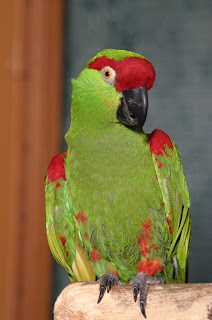What two parrots
are/were native to the United States?
If you were thinking of the Carolina Parakeet (Conuropsis
carolinensis) and the
Thick-billed Parrot (Rhynchopsitta pachyrhyncha), then you are right!
Unfortunately, the
Carolina Parakeet became extinct in the early 1900’s. The Thick-billed Parrot is still in existence, but is an
endangered species. In this
article I will discuss the natural history of this endangered species and introduce
you to Arizona, a Thick-billed Parrot who resides at the World Bird Sanctuary.
Thick-billed Parrots can
only be found in small areas of Arizona and central Mexico. They live at high altitudes in the
conifer forests year round, one of the few parrots of the world that can exist
in cold weather. These parrots
have bright green and red plumage (feather color) with a black beak. They are also known as the Christmas
parrot.
Thick-billed Parrots’ diets
mainly consists of pine nuts, insects, juniper berries, conifer buds, and some
acorns.
Their mating season is
during the summer months. They
generally nest in tree cavities, and their clutch (a group or eggs or chicks)
size can range from two to three eggs. The females lay their eggs during June
or July and then the eggs normally will take a month before hatching. Fledging (leaving the nest) will occur
after two months of staying in the nest.
Their lifespan in the wild is about 30 years and in captivity 40 to 50
years.
Thick-billed Parrots are
small parrots that are about 15 inches long and having a wingspan of about 2.5
feet long. They only weigh 10 to
13 ounces! These parrots are very
social birds that live in flocks, including eating and roosting together. These birds can be very loud and
be heard from over two miles away!
If you have ever visited
the World Bird Sanctuary’s Nature Center or traveled down the exhibit line at
WBS, then chances are you probably spotted the five Thick-bills we have. This number includes a very special
bird--Arizona.
Arizona was hatched in
captivity in 1994, making him 19 years old this year. As a parrot, one of his many great qualities is mimicking
sounds, words, or phrases. Arizona
can do just that! He can say: “Hi,
Hi Zona, Good boy?, Good boy!,
Kiss, What-cha-doin’?, Tequila!, and Bye-bye!”. He seems to love attention and to be
talked to by our visitors.
Arizona’s favorite treats are peanuts and pine nuts. His favorite enrichment toys are his bells and his wooden chew blocks. I love working with Arizona every day because
he always makes me smile and laugh.
There are less than 2,500 Thick-billed
Parrots left in the world today.
They have become endangered because of the illegal pet trade, habitat
loss, climate change (hotter temperatures and increasing fire threats that can
destroy habitats), and predators like birds of prey. Thick-billed Parrots were put on the Endangered Species List
in 1970 by the U.S. Fish and Wildlife Service.
I hope that having learned
a little about these impressive birds you will have the passion to learn more
about what you can do to help them.
Become involved with the Sierra Madre Alliance. This organization helps preserve
old-growth forests for Thick-bills and other birds to nest in. Another way you can help is to support
the World Bird Sanctuary by learning about what we do and passing on that
information to others.
Arizona is available for adoption
in our Adopt a Bird program. To
find out more information, call 636-861-3225. All adoption donations are tax deductible.
This summer Arizona can be
seen at World Bird Sanctuary’s Nature Center, which is open daily from
8am-5pm.
Arizona is a very amazing
little bird that will steal your heart away with just his looks. You should stop on by and see him!








No comments:
Post a Comment